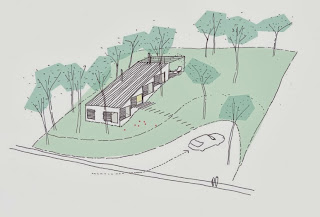Sketch, traditionally a rough drawing or painting in which an artist notes down his preliminary ideas for a work that will eventually be realized with greater precision and detail. The term also applies to brief creative pieces that per se may have artistic merit.
In a traditional sketch, the emphasis usually is laid on the general
design and composition of the work and on overall feeling. Such a sketch is
often intended for the artist’s own guidance; but sometimes, in the context of
a studio-shop type of production, in which an artist would employ many
assistants, sketches were made by the master for works to be completed by
others.
From the 18th century, however, sketch came to take on a new meaning,
which has almost come to supersede the traditional one. The emphasis on
freshness and spontaneity, which was an integral part of the Romantic attitude,
the fact that there was a great increase in the number of unprofessional
artists, and the growing appreciation of nature, accompanied by an expansion of
facilities for travel, transformed the sketch into something regarded as an end
in itself—a slight and unpretentious picture, in some simple medium (pen and
ink, pencil, wash, or watercolour) recording a visual experience. This led to a
revaluation of sketches that had originally been created for other works.
Contemporary taste tends to value sketches as highly finished works.
TYPES OF SKETCHES IN DRAWING PROCESS
Croquis
A croquis
was intended to remind the artist of some person or scene he wished to remember
in a more permanent form - they are not necessarily a finished product.
Pochade
Artists use colour to record a scene's atmospheric effect and to capture the fleeting effect of light for a planned landscape painting. Where croquis is a quick sketch using lines to record an event or person, pochade is a quick colour sketch to capture atmosphere. Many artists use pochade when painting plain air and return with their sketches to the studio to use them in planning large-scale landscape paintings.
Portrait
Sketch
This is used in portrait art to record moments where a person's character is momentarily revealed, a mischievous twinkle in the eye or a sour smile. Sketching was also used to draw the sitter from different angles before deciding which angle was best for the main project. These sketches - whether made with oil paint, watercolour, charcoal or acrylics - typically had a dynamic rhythmic flow which made them worthy stand-alone artworks.
TYPES
OF SKETCHES IN PRODUCT DESIGN PROCESS
Ideation sketches
Ideation
sketches are not about shape and form. It’s more about understanding the
assignment. What does the client want? Who’s it for? What are my resources?
What does it need to do? Examining the problem space, analysing the context.
These ideation sketches consist of pictures and text. It’s not that important
that these sketches communicate ideas to others. The purpose is to translate
the assignment in your ‘words’. These sketches are used to structure and
understand a problem.
Explorative sketches
Explorative sketches are probably the most fun type of sketches. Many design proposals are generated and evaluated. These sketches are produced in large quantities. They are often very rough and do seldom make sense for others than the people directly involved in the design process. Important here is to grasp the overall idea and not to get lost in details.
Explanatory sketches
Explanatory
sketches are the next step in the research stage of the design process. The
amount of these types of sketches is less than the previous type of sketches.
Explanatory sketches are created to explain function, structure and form. They
communicate a design in a clear and neutral manner, focusing more on explaining
the idea rather than selling it. Explanatory sketches must be readable to other
people than those involved in the design process. The first feedback from the
client usually happens after reviewing these sketches.
Persuasive sketches
Persuasive sketches are drawn to influence the audience and to sell the design concept. Some designers tend to use a CAD-program in this stage of the design process rather than sketching the product. Although many people find that sketches have certain invaluable and exclusive characteristics, such as expression and artistic flair which can be difficult to achieve in 3D renderings. Knowledge of more advanced sketching and rendering techniques are used to create persuasive sketches.








No comments:
Post a Comment